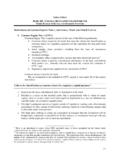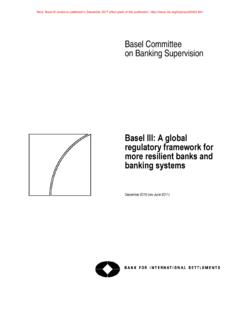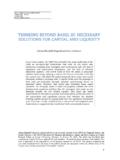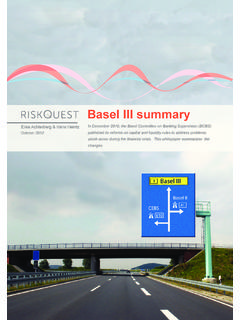Transcription of Bank business models and the Basel system: …
1 OECD Journal: Financial Market Trends 2014 Volume 2013/2 OECD 20141 Bank business modelsand the Basel system : Complexityand interconnectednessbyAdrian Blundell-Wignall, Paul AtkinsonandCaroline Roulet*The main hallmarks of the global financial crisis were too-big-to-fail institutionstaking on too much risk with other people s money: excess leverage and defaultpressure resulting from contagion and counterparty risk. This paper looks at whetherthe Basel III agreement addresses these issues effectively. Basel III has some veryuseful elements, notably a (much too light back-up ) leverage ratio, a capital buffer,a proposal to deal with pro-cyclicality through dynamic provisioning based onexpected losses and liquidity and stable funding ratios.
2 However, the paper showsthat Basel risk weighting and the use of internal bank models for determining themleads to systematic regulatory arbitrage that undermines its effectiveness. Empiricalevidence about the determinants of the riskiness of a bank (measured in this study bythe Distance-to-Default) shows that a simple leverage ratio vastly outperforms theBasel Tier 1 ratio. Furthermore, business model features (after controlling for macrofactors) have a huge impact. Derivatives origination, prime broking, etc., carry vastlydifferent risks to core deposit banking.
3 Where such differences are present, it makeslittle sense to have a one-size-fits-all approach to capital rules. Capital rules makemore sense when fundamentally different businesses are classification: G01, G15, G18, G20, G21, G24, G28 Keywords: Financial crisis, Basel III, derivatives, bank business models , distance-to-default, structural bank separation, banking reform, GSIFI banks* Adrian Blundell-Wignall is the Special Advisor to the OECD Secretary-General on Financial Markets andDeputy Director of the OECD Directorate of Financial and Enterprise Affairs ( ).
4 Paul Atkinson is a former deputy director of the OECD and principal of NHA Economics. Caroline Rouletis an economist and analyst in the OECD Directorate of Financial and Enterprise authors aregrateful for comments made by Delegates at the October 2013 meeting of the OECD Committee onFinancial Markets. This work is published on the responsibility of the Secretary-General of the opinions expressed and arguments employed herein are those of the author and do not necessarilyreflect the official views of the Organisation or of the governments of its member business models AND THE Basel system : complexity AND INTERCONNECTEDNESSOECD JOURNAL: FINANCIAL MARKET TRENDS VOLUME 2013/2 OECD 20142I.
5 IntroductionThe Basel Committee on Banking Supervision (BCBS) has continued to lead the processof bank micro-prudential reform since the global financial crisis in 2008-09, evolving a set ofproposals collectively referred to as Basel latter is a vast improvement over Basel II,which created an across-the-board cut in capital for banks prior to the largest crisis since the1930s. The BCBS proceeded to revise Basel II by adding on to it a vast set of complex primary focus of the BCBS is on capital rules applied to risk-weighted assets; it hasnot been charged with examining the structural business models of banks to which thesecapital rules apply.
6 By necessity the process has been one of policy on the run , which wasnot able to benefit from any evidence-based research. As more and more data on banks sincethe crisis comes to hand this situation is changing, and the relative importance of businessmodel factors and capital and liquidity rules in influencing the riskiness of banks can betested. This paper reviews the Basel III proposals, presents new evidence about the factorsdetermining the riskiness of banks, and asks whether structural reform of banks businessmodels is a necessary part of the reform are two broad paths to bank failure: fundamental insolvency and/or liquiditycrises typically arising from counterparty risk.
7 A sudden decline in asset values (if properlymarked to market) can wipe out bank capital. But the very risk of this in a crisis makescounterparties unwilling to lend, which is especially problematic when banks need cashand/or liquid securities to meet margin calls for derivatives transactions, repos and othercollateral depends very much on the structural business model of banks. Badassets, on the other hand, are easier to hide, particularly when they are illiquid, rely onmark-to-model valuations and/or are held to maturity in banking assetsmay take many years to mature, at which time their true recovery value is realised.
8 If it isbelow the previously reported value write-downs will follow, and this can go on for someyears after a crisis. Banks in this position (latent insolvency with bank and regulatoryforbearance) are often forced into deleveraging and asset sales. Less important banks aresometimes forced to fail, though this discipline has been more common in the USA than inEurope. Where banks are systemically important, governments do intervene to lessen thedeadweight losses to the economy from a systemic crisis, and this sort of implicitguarantee can lead to the under-pricing of risk, causing leverage and counterparty risk tobe higher than it would otherwise be.
9 The bank is rewarded if the strategy works and thetaxpayer bears the risk alongside shareholders if it , policy makers have at times, particularly in the USA, combined capital ruleswith policies that constrain the business models of banks (such as Glass-Steagall). But thiswas gradually undermined by the great push for deregulation in the past few decades. At thenational level regulators are implementing the capital rules in different ways and are alsocombining this with some attempts to constrain certain aspects of what banks actuallydo, banks business models (Vickers, Volcker, Liikanen, and Swiss separability requirements).
10 4 This paper first looks at the Basel system historically, and then summarisesBANK business models AND THE Basel system : complexity AND INTERCONNECTEDNESSOECD JOURNAL: FINANCIAL MARKET TRENDS VOLUME 2013/2 OECD 20143most of the key problems with it that contributed to the failure of regulation to avoid therecent global financial crisis. In Section II the paper summarises the recent Basel IIIproposals, and Section III critically analyses them. Section IV presents new empiricalevidence on leverage and business model features that make banks risky and hence need tobe addressed by section argues that structural business model measures areessential alongside capital rules for large banks.

















